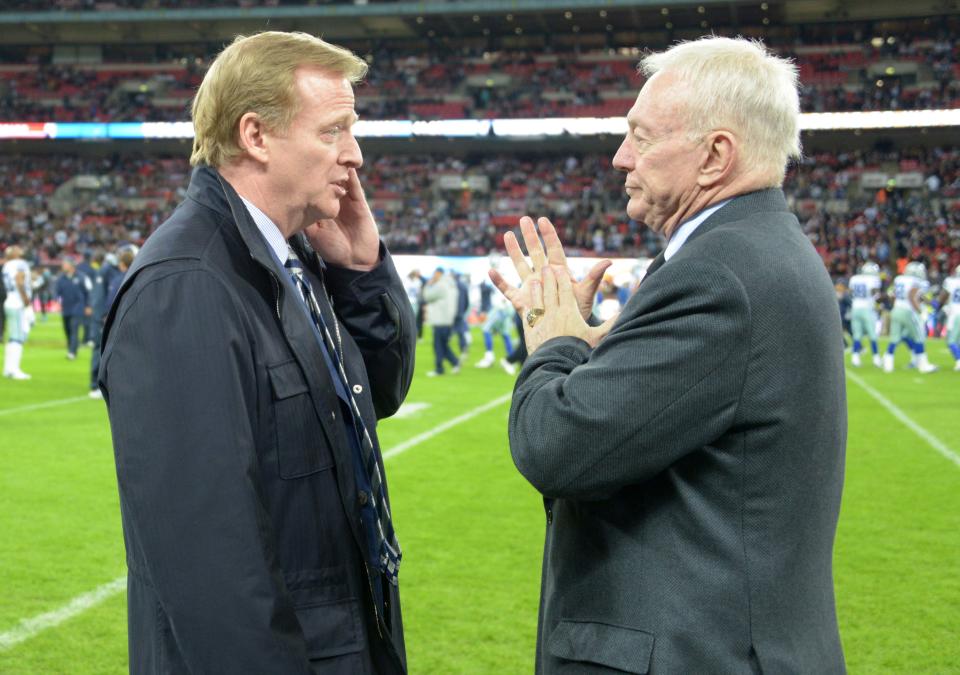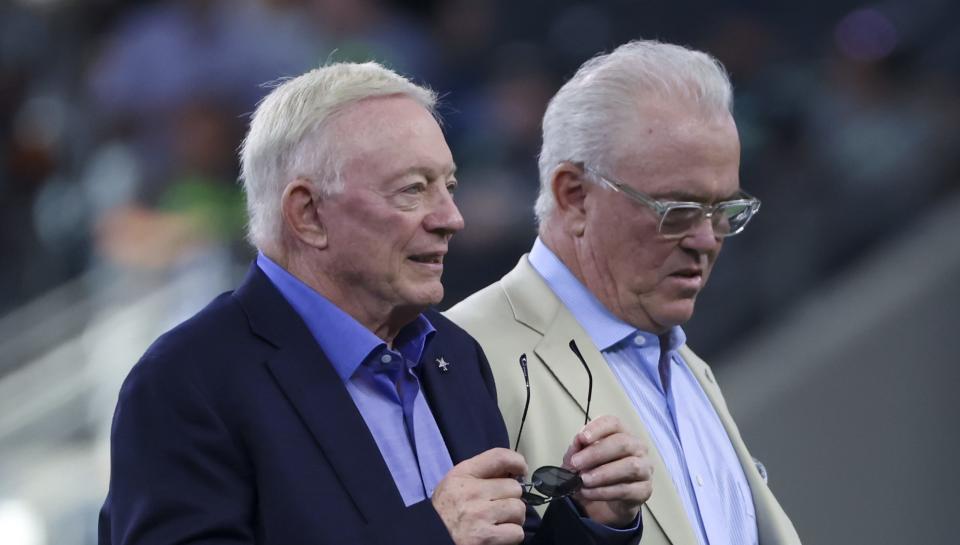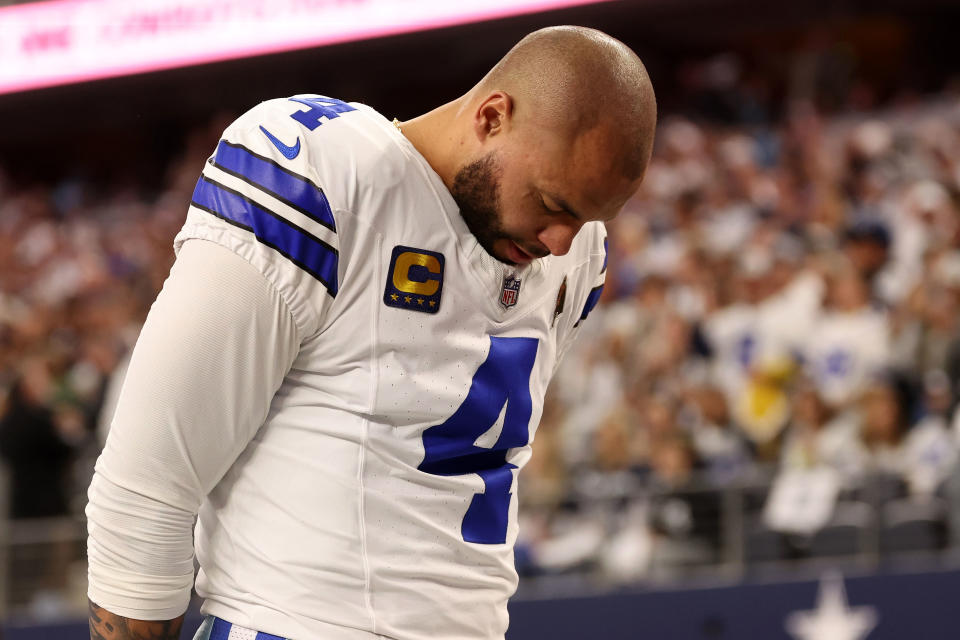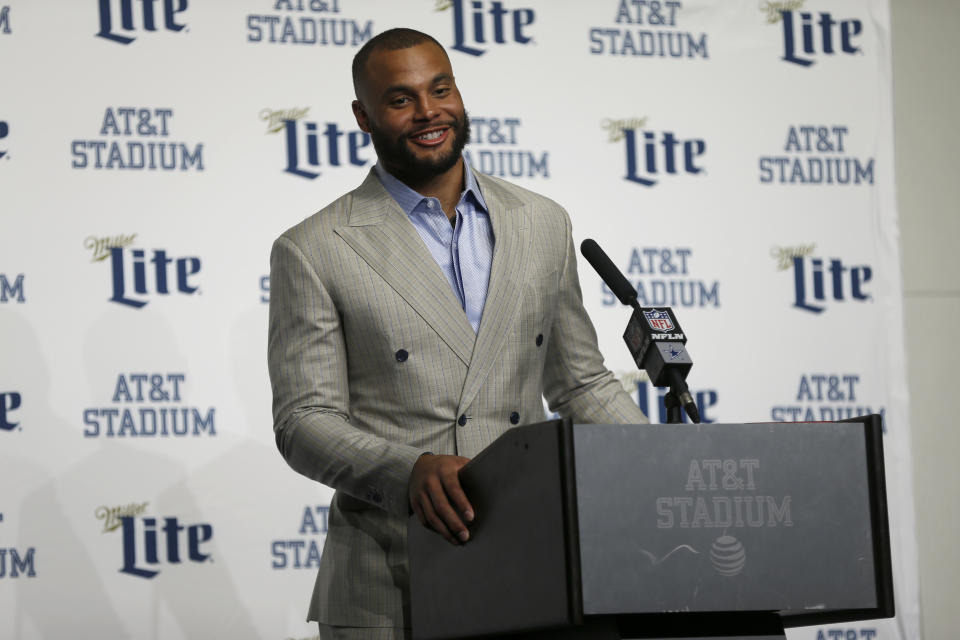$255M salary cap gives Cowboys new flexibility in Prescott negotiations

It’s now easier for the Dallas Cowboys to walk away from Dak Prescott. On Friday, the NFL released the figures for the 2024 salary cap, $255.4 million, steamrolling past previous projections. Originally the number was rumored to be between $240 million and $245 million. The actual number comes in $13 million above the median of that range and Stephen Jones has to be ecstatic.
Why? Because it keeps them from being strong armed in the Dak Prescott contract negotiations. Don’t get it twisted, Prescott still has like 80% of all of the leverage here, but blowing things up just became a little bit more palatable for the Jones family. Even if they do end up signing Prescott long-term, the extra room means they don’t have to resolve Prescott’s situation before addressing other needs. If nothing else, the additional cap space buys the Cowboys time.
Prescott currently sits with a $59.5 million cap hit that can be easily reduced in many ways. The most likely way is that the team works out an extension that makes him the highest paid player in league history, but reduces the 2024 impact on the cap. But now, with this extra $13 million in space they can play a little more hardball because it’s not as catastrophic to their offseason to not get space from Prescott’s deal.
TL;DR: The video version of the conversation
(Editor’s Note: Updates to Osa Odighizuwa and Sheldrick Redwine occured after the video was recorded, changing Dallas’ cap debt around $1.7 million).
The NFL is rolling in the dough... primer on how the cap works

The annual salary cap is the spending limit each NFL team is allowed to hit across an NFL season. A team’s number is calculated based on base salaries, bonus allocations (more on that later) and incentives.
Base salaries are straight forward. Bonus allocations, which includes signing bonuses, option bonuses and restructure bonuses, are handled a bit differently. While they are paid out in one year, teams are allowed to spread the impact of a bonus across up to five years of a player’s contract. If a player is no longer on the team, but had bonuses allocated to future year’s caps, it’s referred to as dead money.
Incentives are divided into two categories, with some being counted against a team’s cap at the beginning of the year, and some not counting until after the season is over.
The annual cap number each team is allowed is determined by a convoluted formula that bundles together various percentages of the various ways the league makes money: ticket sales, merchandising, TV contracts and gambling. Not all revenue is included (though they hilariously name the calculation “all revenue” in the CBA) and there’s several clauses around it, but that’s the general gist.
Cowboys merchandising and the Giants/Jets stadium are the two noteworthy exceptions from this calculation, but the cap is primarily set up to be around 48% of this number.
Add up the $255.4 million cap for all 32 teams and it amounts to over $8.1 billion in salaries, which means the NFL made at least $17 billion in 2023, and that’s just the part of revenue used to calculate salaries.
That gambling money is absolutely rolling in. There were signs of it last season when the cap jumped $16 million, but a $30 million increase is insane. The only bigger jump in history was after they went backwards in 2021 because of the pandemic. The addition of the 17th game of revenue, an extra playoff game, streaming plus partnering up with all of the legalized gambling outfits means the league is rolling in dough even more than before.
2024 Cowboys situation

According to Over the Cap, the Cowboys are going to be around $10 million over the $255.4 million cap, and they have until the beginning of the new league year (March 5) to get this number down.
(Editor’s Note: Updates to Osa Odighizuwa and Sheldrick Redwine occured after the video was recorded, changing Dallas’ cap debt around $1.7 million).
This number includes the $4.9 million of unused cap space from the 2023 season; a figure that could fluctuate over the next couple weeks as incentive numbers from last year are finalized. Some incentives that were included in the cap calculations before last year (Likely-to-be-earned, or LTBE) but weren’t earned are refunded to the cap space. Others that weren’t included (NLTBE) are taken out.
Teams generally like to take at least $5 million to $8 million of spare cap space into each season, to replace guys who go on IR or possibly trade for missing pieces.
All rolled together, the Cowboys probably have a soft ceiling of around $251 million for the 2024 season.
So how does this all impact the Prescott negotiations? Well, now it’s a lot easier for the Cowboys to have enough space to still add free agents even if they don’t get a new deal done with Prescott.
Prescott loses some leverage

In the last round of negotiations, Dallas exercised their leverage by using the franchise tag on Prescott. Prescott now has the upper hand. Prescott had three major pieces of leverage entering the offseason, aside from finishing second in MVP voting. He negotiated a no-trade clause, negotiated a no-tag clause and has such significant cap numbers in his final year and void year (2025) that he is in the driver’s seat.
The Cowboys were projected to be around $23 million over the cap prior to the actual cap numbers.
They have around $43.5 million of space they can create without touching Dak Prescott’s contract. This would be extending players like CeeDee Lamb, Zack Martin, DeMarcus Lawrence, restructuring Trevon Diggs and walking away from Michael Gallup.
Before the new numbers, this meant just $20 million in space. That may seem like a lot, but one-year deals eat up that number really quickly as do free agents who have large signing bonuses.
Dallas is now in a much better position to be players in the first wave of free agency with $33 million of wiggle room without touching Prescott’s deal.
They are no longer forced into a corner should they not see eye-to-eye on Prescott’s value; they can still go all-in this year (to some degree) and play hard ball with Prescott.
Part of Prescott’s leverage was timing. Dallas needed to work out Prescott’s deal before the new league year or they wouldn’t have the space. At a minimum, the extra $13 million gives Dallas the ability to walk away from Prescott negotiations to go deal with other players, should things not materialize quickly,
But only some leverage

At the end of the day, Prescott is still in a pretty powerful position and the Cowboys front office continues to insist they are interested in a long-term relationship with him.
Prescott is going to cost at least $57.5 million a season on average, and there are prior deals and escalations on record where he and agent Todd France could be seeking as much as $62.5 million. There’s a world where they ask for that with a sizable enough chunk of it being guaranteed where the Joneses decide they aren’t willing to go there.
If that’s the case, and they chose any of the six realistic options that does not include a long-term agreement, there’s now more breathing room to still make other moves.

